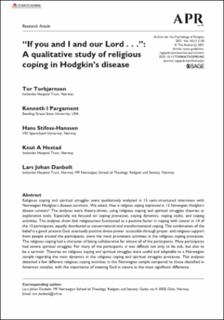| dc.contributor.author | Torbjørnsen, Tor | |
| dc.contributor.author | Pargament, Kenneth I | |
| dc.contributor.author | Stifoss-Hanssen, Hans | |
| dc.contributor.author | Hestad, Knut | |
| dc.contributor.author | Danbolt, Lars Johan | |
| dc.date.accessioned | 2023-02-22T10:19:02Z | |
| dc.date.available | 2023-02-22T10:19:02Z | |
| dc.date.created | 2021-02-25T13:14:33Z | |
| dc.date.issued | 2021 | |
| dc.identifier.citation | Archive for the Psychology of Religion/ Archiv für Religionspsychologie. 2021, 43 (1), 3-20. | en_US |
| dc.identifier.issn | 0084-6724 | |
| dc.identifier.uri | https://hdl.handle.net/11250/3053136 | |
| dc.description.abstract | Religious coping and spiritual struggles were qualitatively analyzed in 15 semi-structured interviews with Norwegian Hodgkin’s disease survivors. We asked, How is religious coping expressed in 15 Norwegian Hodgkin’s disease survivors? The analyses were theory-driven, using religious coping and spiritual struggles theories as explorative tools. Especially we focused on coping processes, coping dynamics, coping styles, and coping activities. The analyses show that religiousness functioned as a positive factor in coping with cancer in 14 of the 15 participants, equally distributed as conservational and transformational coping. The combination of the belief in a good, present God, eventually positive divine power, accessible through prayer, and religious support from people around the participants, were the most prominent activities in the religious coping processes. The religious coping had a character of being collaborative for almost all of the participants. Many participants had severe spiritual struggles. For many of the participants, it was difficult not only to be sick, but also to be a survivor. Theories on religious coping and spiritual struggles were useful and adaptable to a Norwegian sample regarding the main dynamics in the religious coping and spiritual struggles processes. The analyses detected a few different religious coping activities in this Norwegian sample compared to those identified in American samples, with the importance of meeting God in nature as the most significant difference. | en_US |
| dc.language.iso | eng | en_US |
| dc.rights | Navngivelse-Ikkekommersiell 4.0 Internasjonal | * |
| dc.rights.uri | http://creativecommons.org/licenses/by-nc/4.0/deed.no | * |
| dc.subject | Religiøs mestring | en_US |
| dc.subject | Mestring | en_US |
| dc.subject | Hodgkin's disease | en_US |
| dc.title | “If you and I and our Lord . . .”: A qualitative study of religious coping in Hodgkin’s disease | en_US |
| dc.type | Peer reviewed | en_US |
| dc.type | Journal article | en_US |
| dc.description.version | publishedVersion | en_US |
| dc.subject.nsi | VDP::Teologi og religionsvitenskap: 150 | en_US |
| dc.subject.nsi | VDP::Theology and religious studies: 150 | en_US |
| dc.source.pagenumber | 3-20 | en_US |
| dc.source.volume | 43 | en_US |
| dc.source.journal | Archive for the Psychology of Religion/ Archiv für Religionspsychologie | en_US |
| dc.source.issue | 1 | en_US |
| dc.identifier.doi | 10.1177/0084672420983482 | |
| dc.identifier.cristin | 1893688 | |
| cristin.ispublished | true | |
| cristin.fulltext | original | |
| cristin.fulltext | original | |
| cristin.qualitycode | 2 | |

